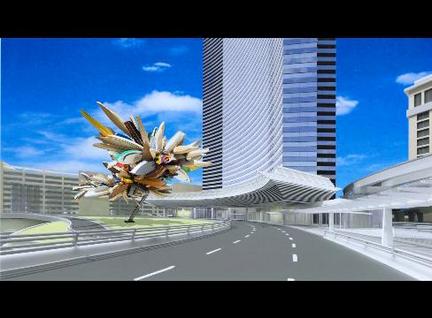main: March 2008 Archives
On April 11 in North Carolina, Glenn Harper, Editor of Sculpture Magazine and Bill Thompson, Editor of Landscape Architecture, and I meet to kick off the "Public Art 360" Conference. Click Here to Attend. In the next few weeks, I will publish some of my letters to Harper and Thompson in preparation for the dialogue.
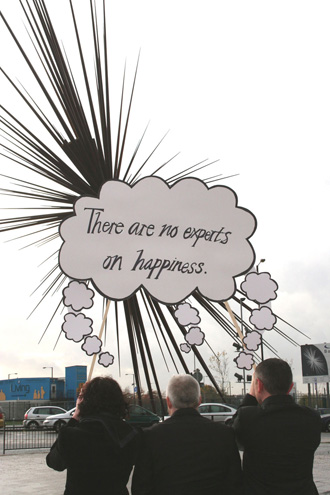
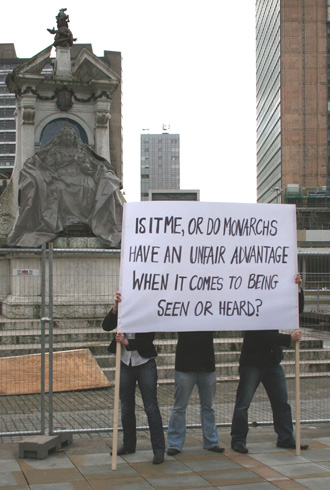
LATE ADDITION
SEE GOOD COMMENTARY BY RIES IN THE COMMENTS.
Subscribe to Aesthetic Grounds Bi-Weekly Summary:
Digg it...Del.icio.us ...Technorati...Stumble Upon..Reddit
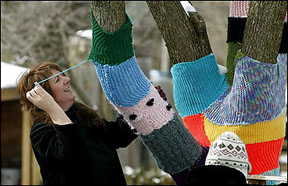 At the end of last week, two public art projects competed for media attention in the USA. In the small town of Yellow Springs, Ohio, a few local women knitted a sweater for ONE tree during a winter day. Any volunteer knitter could climb the eight-foot ladder and add her wrap to the tree trunk or limb. In Las Vegas, two of world's largest resort and gaming corporations announced a $40 million dollar expenditure for fine art at the future CityCenter $8 billion casino and resort. New huge artworks have been commissioned from Jenny Holzer, Nancy Rubins, Maya Lin and Richard Long plus the display of large existing works by Oldenburg/ van Bruggen, Frank Stella and Henry Moore.
At the end of last week, two public art projects competed for media attention in the USA. In the small town of Yellow Springs, Ohio, a few local women knitted a sweater for ONE tree during a winter day. Any volunteer knitter could climb the eight-foot ladder and add her wrap to the tree trunk or limb. In Las Vegas, two of world's largest resort and gaming corporations announced a $40 million dollar expenditure for fine art at the future CityCenter $8 billion casino and resort. New huge artworks have been commissioned from Jenny Holzer, Nancy Rubins, Maya Lin and Richard Long plus the display of large existing works by Oldenburg/ van Bruggen, Frank Stella and Henry Moore.
Here is the result of "Head to Head" public art media blitz.
Yellow Springs Knitters
·
Strategy: Someone must have known a local AP stringer. Stringer pitches story to AP. Report with picture hits the AP wire.·
Results: Multiple publications in daily newspapers across the United States including Washington Post, NY Times, Boston Globe, International Herald Tribune, etc, etc, etc.·
Economic Development: Yellow Springs spreads its reputation as an "artsy" community.MGM Mirage and Dubai World
·
Strategy: Write the article in the form of a press release and distribute via prnewswire.com. Call up editors and reports at various papers. Push hard.·
Results: One print article outside Nevada in the NY Times with online slide show that was picked up and republished in Taipei. Partial or full posting of prnewswire text on online business or gaming websites.·
Economic Development: Las Vegas has upscale resorts equivilent to Dubai.
Nancy Rubin Proposal for CityCenter
I am interested in why the Yellow Springs knitters out paced MGM Mirage. The greater success Yellow Springs comes from the actual installation of the artwork, not just a story about the future. Real people and their honest reactions could be interviewed on the streets near the tree. The NY Times had to stretch to find a few quotes and a very staged picture of Ms. Lin with a tiny segment of her silver river.
Yellow Springs had other advantages that public art programs might note. The artwork was colorful and clearly understood by a single photograph - strips of knit fabric tightly wrapping the trunk and limbs by local women as a celebration of winter and their own joyful spirit. The visual effect was dynamic on the tree.
 As reported by AP, Corrine Bayraktaroglu, an artist who helped start the "knitknot tree" project, stated: "People are really, really enjoying it. They're coming from towns to have their photograph taken with the tree."
As reported by AP, Corrine Bayraktaroglu, an artist who helped start the "knitknot tree" project, stated: "People are really, really enjoying it. They're coming from towns to have their photograph taken with the tree."
How many civic art programs strive for this reported comment on an abstract, design-integrated public artwork: "It looks like Yellow Springs; it's unique, it's colorful, unpredictable," said Lynda Sirk. "It makes me smile. That's what I like." Unique, colorful, unpredictable - all words welcome in any critical commentary on Nancy Rubins, Frank Stella and Oldenburg/van Bruggen in Las Vegas.
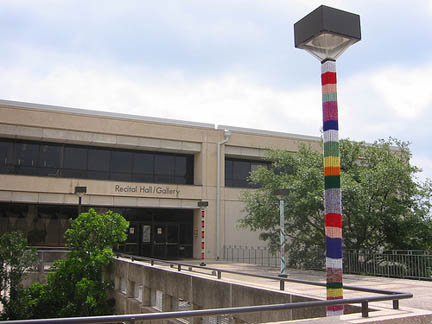
Houston's Knitta wrapping light poles in San Antonio
I was surprised to learn that knitted artworks for the street are a practiced artform. A group of six artists from Houston called Knitta have been collectively wrapping elements of the street for the last three years. A knittaplease photo collection is available on Flickr.
Tree Cozies in Indiana (photos "The Republic")
Also this winter is the tree cozy competition in Columbus, Indiana. 30 artists wrapped the lower trunk of 30 street trees with knitted works. Alice Dorwsky (spelling help?) of New England has been making beautiful yellow wraps and tree hangings for the last few years.
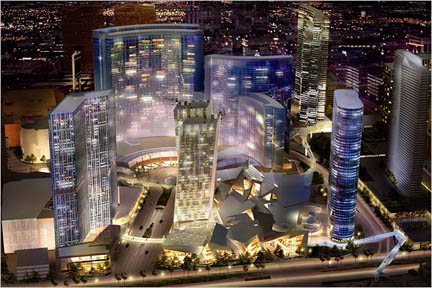
CityCenter Design (NY Times Slide Show)
Back to CityCenter in Las Vegas. What to make of the end of bad taste in Sin City? When Steve Wynn added art to his other casinos in the 1990s, the art was tasteful, but not the setting. With CityCenter line up of architects - Foster, Pelli, Vinoly and Libeskind - now the French and other European critics will stop commenting and Japanese youth will stop visiting. Viva Las Vegas might be approaching retirement. Even Las Vegas can become just another flashy resort. What could be worse?
For the record, $40 million is only one-half of a percent (1/2%) of the $8 billion project. So although it sounds and IS a lot of money for art, a typical 1% for art program would receive $80 million.
But still the world was more interested in the $50 dollars of yarn in Yellow Springs this weekend.
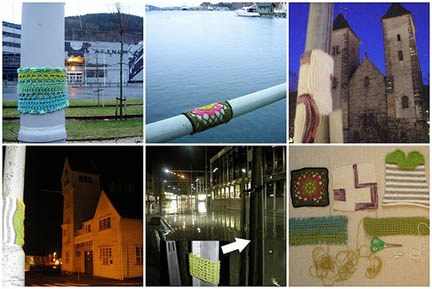
Twice I read Derek Merrill & Beau B. Beza's essay in Refractory: a Journal of Entertainment Media. The writers utilize the concept of the "screen" to explore Atlantic Station development in Atlanta, Georgia. Atlantic Station is a environmental urban brownfield redevelopment and reclamation of the 100-year-old Atlantic Steel Mill requiring the removal of 9,000 dump truck loads of contaminated soil. The 138-acres are divided into three zone: mixed use outdoor shopping mall with 6 million SF of office highrise space, mid-rise apartments surrounding a wetland and the IKEA store. Due to the terrain and earth removal, all the public parking is below ground providing much more flexibility in pedestrian space design.
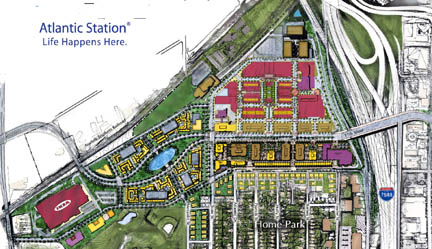
I wrote Merrill and Beza that the screen was a poor choice of words to assist with the analysis. It was a forced metaphor regarding the spatial conception. I visit as many new urbanist places as possible to understand them. The designers conceive these developments as a series of territorial types, which are set next to each other. Each territory has an aesthetic heart (round, linear or grid) that is defined with building facades.
Once leaving the hearts, transitions between territories are very awkward and rely on the road to rudely connect them. The locations of the screens are the empty car zones of garages, parking lots, alleys or highways. The resident and visitor are supposed to mentally ignore these places like the toilet in the mansion. The leftover space is just that.
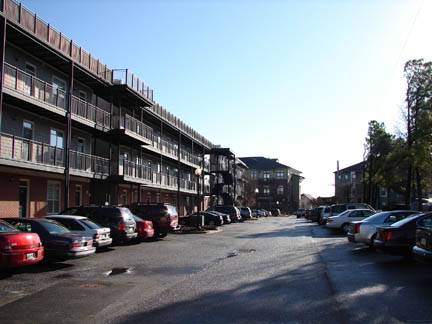
Harbor Town leftover space. (Frequently praised as multi-use parking)
The key to the spatial failure is the unrelenting demand for tiny heart after tiny heart. Each territory is not provided enough space to establish the vernacular repetition and controlled variation that we understand as a neighborhood or city. Without enough territory for natural repetition, control will be the psychological sense of the place. And control is the generator of discomfort for the some and the source of security for others. For many bloggers - extreme discomfort.
The irony is that the tiny hearts or odd spaces of containment are the moments we seek and remember in the suburban or low-scale urban environments. Somehow when designed, the feeling is control and not joy. The joy arises from the efforts of single person with a little imagination or a failure of coordination in the overall design.
When examining new urbanism, I must always remember that it is a developer's alternative to the gated suburban apartment complex and single-family neighborhood. New urbanism should be judged against the other choice for newness - not the neighborhoods with centuries or decades of demolition and remodeling. Eventually these places will be personalized and the control may dissipate. Or like the highly controlled of designs of late 19th and early 20th century religious retreats or military bases, the control will seem benign and part of another era. The museum viewing or resort dwelling instincts will take hold and replace the judgment standards of neighborhood living.
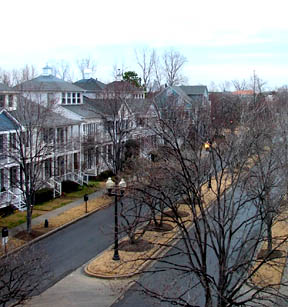
Recently, I visited Memphis and had the opportunity to spend a couple nights in the River Inn in Harbor Town. Harbor Town is one of the older new urbanist developments in the USA with the first sales in 1991. The mature landscape and some personalization have already emerged. The commercial mixed-use area has a messiness with different building types and scales that humanizes the space. It appears the architects - Loney Ricks Kiss - where designing by accommodation that than preconception. The personalization arises when the overall structure fails to resolve the space and the individual architects, gardens and owners must find a solution. Harbor Town proves the new urbanist system can succeed without the stylistic and spatial tyranny.
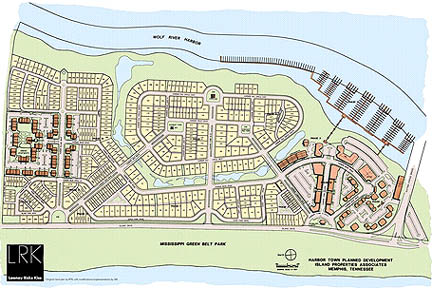
Harbor Town site plan on the Mississippi River by LRK.
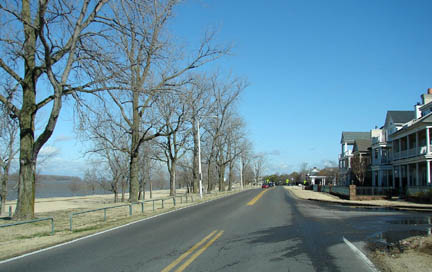
Front onto the Mississippi River
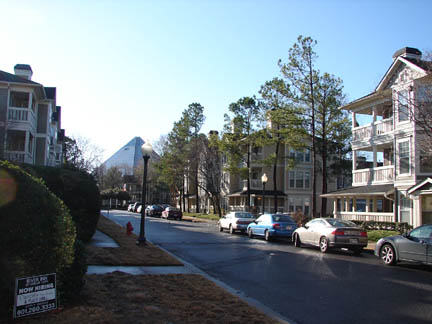
Harbor Town mature trees (Note the Memphis pyramid)
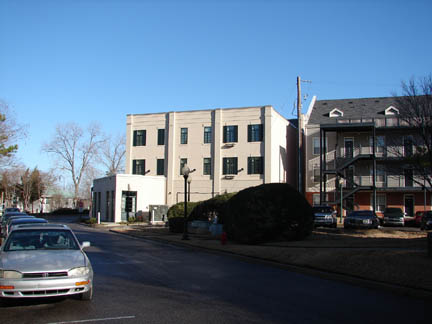
Harbor Town with a little age and inconsistency
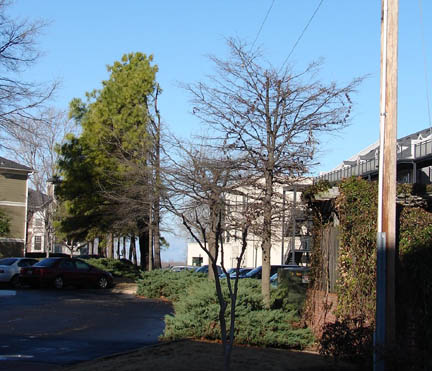
The imperfections start to emerge after 15 years.
Digg it...Del.icio.us ...Technorati...Stumble Upon..Reddit
NEW ORLEANS
"Next American City" Explores New Orleans
Free
SYMPOSIUM:Sparking Creativity: Investing in Entrepreneurship and Human Capital Post-Katrina,
Thursday, March 6, 2008, 6-8 pm
A small business is not just a building. It's an investment in a person who is willing to invest back into their community. As post-Katrina New Orleans struggles to rebuild itself, we ask the question, What is there to invest when there is nothing to provide to a community. More importantly, what is there to provide when there is no community?
Saturday, March 8, 2008
On the Ground for 24 Hours in New Orleans. Join the Next American City staff and friends for a 24 exploration of New Orleans. Meet the group at Jackson Square in the French Quarter, across from the St. Louis Cathedral at 11a.m. on Saturday. (As on March 4, the Brad Pitt's pink house project has 79 sponsors of new houses. Still 71 to go to 150 homes in the ninth ward. )
Check out the documentation on the Philly 24 Hours as a sample of the New Orleans tour.
ATLANTA
Public Art Resource Expo, Free
Museum of Contemporary Art, Atlanta, GA
March 15, 2008, 10:00-4:00
A networking day for artists, private developers, architects, civic leaders and the general public to learn about public art and to discover available opportunities, services, vendors, and resources. Free admission. For more information: dmcduggie@atlantaga.gov
BOSTON
Sustainable Design: At the Crossroads of Art, Policy and Science
Hynes Convention Center, Boston
March 29, 2008 at 1:00 PM
Free
A joint program of the UrbanArts Institute at Massachusetts College of Art and Design, Goethe-Institut Boston and Down:2:Earth (D2E), a sustainable living expo at the Hynes Convention Center. The panelists will explore sustainable design in the context of art, science and policy and showcase environmentally responsible products and places. Go see Singer if you have not heard him speak. The others appear more product oriented, but "green" is still a hands-on "garage" business. Before the corporations take over, enjoy the final days of invention by real people.
Michael Singer, Artist/Designer
Ursula Tischner, Cologne, Germany
Teresita Cochran of Smit Design
Moderated by Terry Swack, Founder/CEO, Clean Culture
NORTH CAROLINA
Public Art Symposium: Public Art 360
Chapel Hill, North Carolina
Friday evening April 11 and all day Saturday April 12, 2008
$60.00
A symposium that goes beyond education on public art. The symposium has the potential to spark some valuable dialogue that might be carried onto Philadelphia and Grand Rapids later. When Janet Kagan asked me to speak, I said I would pay my own way if she could get the editors of Sculpture Magazine and Landscape Architecture on the stage talking about the public art. She did it. If you fly to one educational event in 2008, this could be the one. Fly into Greensboro, Charlotte or Raleigh airports and drive through the dogwoods to the University of North Carolina. North Carolina is pretty and smart. www.publicartcollaborative.org
Friday Night, April 11
Glenn Harper, Editor of Sculpture Magazine
Bill Thompson FASLA, Editor of Landscape Architecture
Glenn Weiss, Aesthetic Grounds of Arts Journal
Just a few on Saturday, April 12
Janet Eshelman, Artist of the giant net coming to Phoenix
Brett Cook, Artist of Community Building
Walter Hood, Landscape Architect / Public Artist
Robert Frasca, Architect supporting Public Art
Sarah Herda, Graham Foundation and Formerly at the Storefront
SOUTHERN CALIFORNIA
The First Desert Cities Public Art Forum: "Facing Public Art Challenges and Finding Solutions"
Palm Desert, California
Public Art Professionals Day with Jessica Cusick, Public Art Manager, Santa Monica
Friday, April 4, 2008, 9:30 to 3:00 PM
Public Artists' Day with Cliff Garten, Artist
Saturday, April 19, 2008, 9:30 to 3:00 PM
Free but must register by March 20th, 2008
BOSTON
8th Annual Systems for Inclusion
Harvard University, Graduate School of Design, Cambridge, MA
Friday, April 4th at 6:00 PM to Sunday, April 5th at Noon.
$35 to $150 for income different groups
Systems for Inclusion explores the interface of design and systemic social action: Can design(ers) challenge globally networked systems of exclusivity and inequality? What are the relationships between design and political power, economic and ecological sustainability, justice and community? 8th year organized by the Design Corps. Excellent line up of designers discussing the AVOIDED in design dialogue: social sustainability, community design, political art, political power, etc. The great Japanese architect Shigeru Ban speaks on Friday night.
WESTERN MASSACHUSETTS
Symposium: Art in the Public Sphere: Singular Works, Plural Possibilities
University Gallery, University of Massachusetts, Amherst, MA
Friday, April 25, 2008 from 9:30 am to 4:30 pm
Free
A day long series of conversations and panel discussions with uMass scholars and internationally known experts such as Vito Acconci and George Trakas, public art curators Ann Pasternak (director of Creative Time) and Rick Lowe (artist and founder of Project Row Houses in Houston); will provide a critical forum to consider various theories, processes, and models for artistic intervention. Symposium.
FLORIDA
Annual Conference of Florida Public Art Administrators
Orlando, Florida
May 7 - 9, 2008
$150
For ten years, the public art administrators have been gathering in a Florida city to discuss common issues and the tour the local artworks. Well-organized and informal. Guest administrators welcome.
PHILADELPHIA
Americans for the Arts Conference, Public Art Track
June 19-22, 2008
$500 for all days or $275 for one day.
This is the networking and learning event for public art in the United States. The conference is pricey since the 1 ½ day special public art pre-conference was merged with the big conference for all the arts. For those of you with less cash or time, pay the one-day fee and come for all day Sunday, June 22nd. The best projects in the USA are visually presented at noon. Several potentially good panels from artists, critics and curators. I am praying that the last panel on Sunday - Public Art: The Next Generation will have something crucial and critical to yell. Sunday ends with a gathering at the Philadelphia Museum of Art - always a pleasure. Parties at local public artist studios are rumored for Saturday night. Complete schedule at Public Art Track and at Public Art Panels.
Digg it...Del.icio.us ...Technorati...Stumble Upon..Reddit
Imagine an argument about the value of surprising public art and well-designed public space.
Interesting that I feel the need to add "well-designed" to public space. Public space ALWAYS exists so it MUST BE qualified. Public art is always an optional ADDITION and very, very rare when compared to the quantity of public space. [Perhaps I am wrong and the value of the gigantic ether of nearly invisible public space needs consideration. Many observers note the reduction in public space by "corporate interests" with the loss of the democratization of any and all publicly accessible space that was gained in 20th century. Not really less space, but a transformation of "id" space into "super-ego" space.]
I choose "surprising" because all good artworks must reach beyond my expectations on every real viewing. The work and its site must have the ability drag me back to look, to feel and to think again. A surprise that demands as much work from me as the object or space.
Satisfaction of the anticipated is not enough, but is generally the highest achievement of government projects of all types. The successful risk takers in government administration raise the level of the anticipation. This is a tricky business. The risk taker must convince others in power that the public's level can also be raised and then satisfied. I once witness the director of the Seattle Public Library raise the level such that only architect Rem Koolhaas could satisfy the level. Brilliant.
We are seeing this in the Democratic primary where Obama has successfully raised anticipation for a "people-serving government" and Clinton has called into question his ability to achieve the result. As per all questions in government (public art and public space), the voters are choosing between guaranteed lower level achievement and a hope for a higher level.
The definition of well-designed might be the satisfaction of the anticipated. As government public art programs age, "well-designed" becomes a popular adjective. We desperately need to renew the surprise in public art.
Digg it...Del.icio.us ...Technorati...Stumble Upon..Reddit
Blogroll
AJ Ads
AJ Blogs
AJBlogCentral | rssculture
Terry Teachout on the arts in New York City
Andrew Taylor on the business of arts & culture
rock culture approximately
Laura Collins-Hughes on arts, culture and coverage
Richard Kessler on arts education
Douglas McLennan's blog
Dalouge Smith advocates for the Arts
Art from the American Outback
For immediate release: the arts are marketable
No genre is the new genre
David Jays on theatre and dance
Paul Levy measures the Angles
Judith H. Dobrzynski on Culture
John Rockwell on the arts
Jan Herman - arts, media & culture with 'tude
dance
Apollinaire Scherr talks about dance
Tobi Tobias on dance et al...
jazz
Howard Mandel's freelance Urban Improvisation
Focus on New Orleans. Jazz and Other Sounds
Doug Ramsey on Jazz and other matters...
media
Jeff Weinstein's Cultural Mixology
Martha Bayles on Film...
classical music
Fresh ideas on building arts communities
Greg Sandow performs a book-in-progress
Exploring Orchestras w/ Henry Fogel
Harvey Sachs on music, and various digressions
Bruce Brubaker on all things Piano
Kyle Gann on music after the fact
Greg Sandow on the future of Classical Music
Norman Lebrecht on Shifting Sound Worlds
publishing
Jerome Weeks on Books
Scott McLemee on books, ideas & trash-culture ephemera
theatre
Wendy Rosenfield: covering drama, onstage and off
Chloe Veltman on how culture will save the world
visual
Public Art, Public Space
Regina Hackett takes her Art To Go
John Perreault's art diary
Lee Rosenbaum's Cultural Commentary
Tyler Green's modern & contemporary art blog
